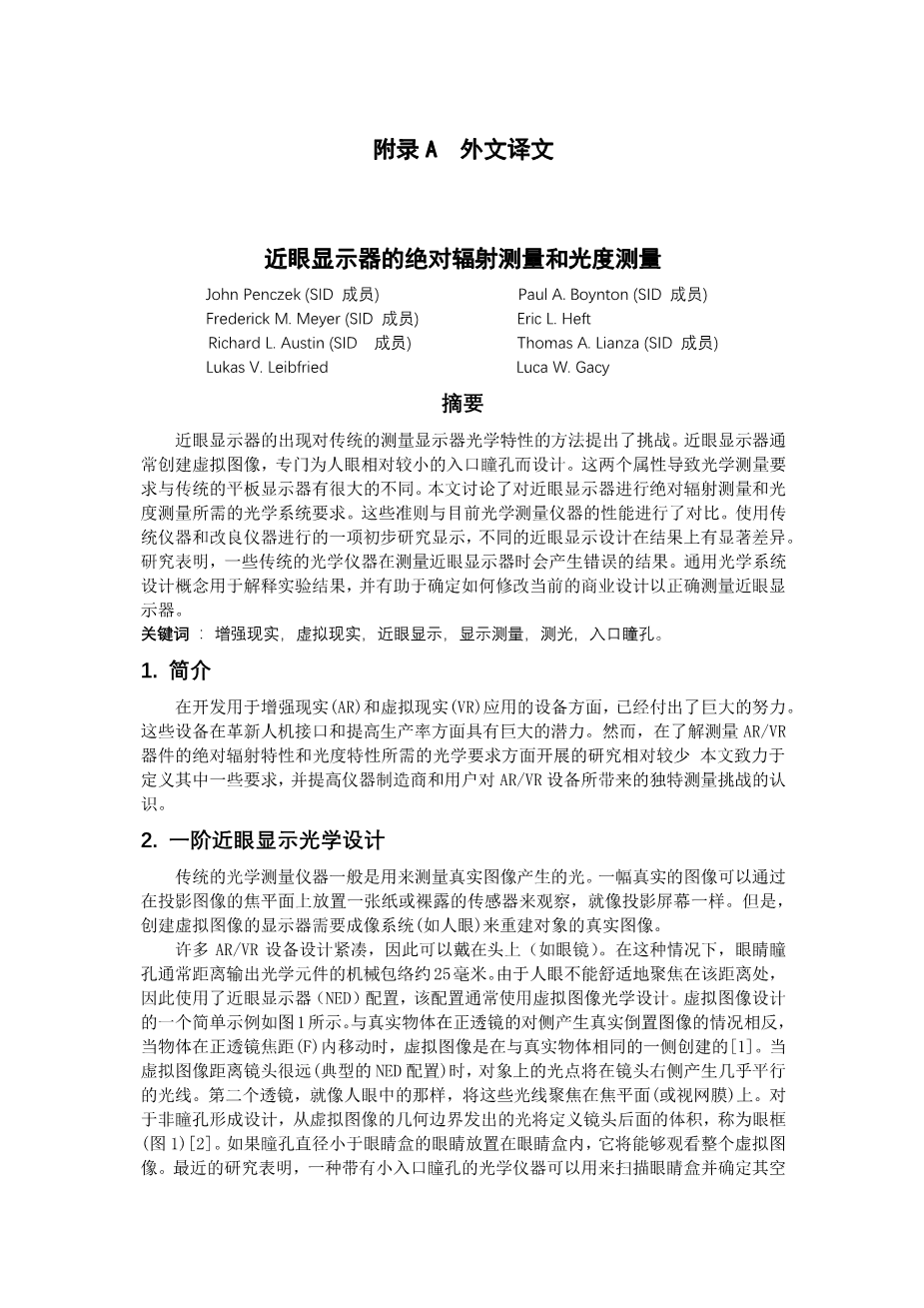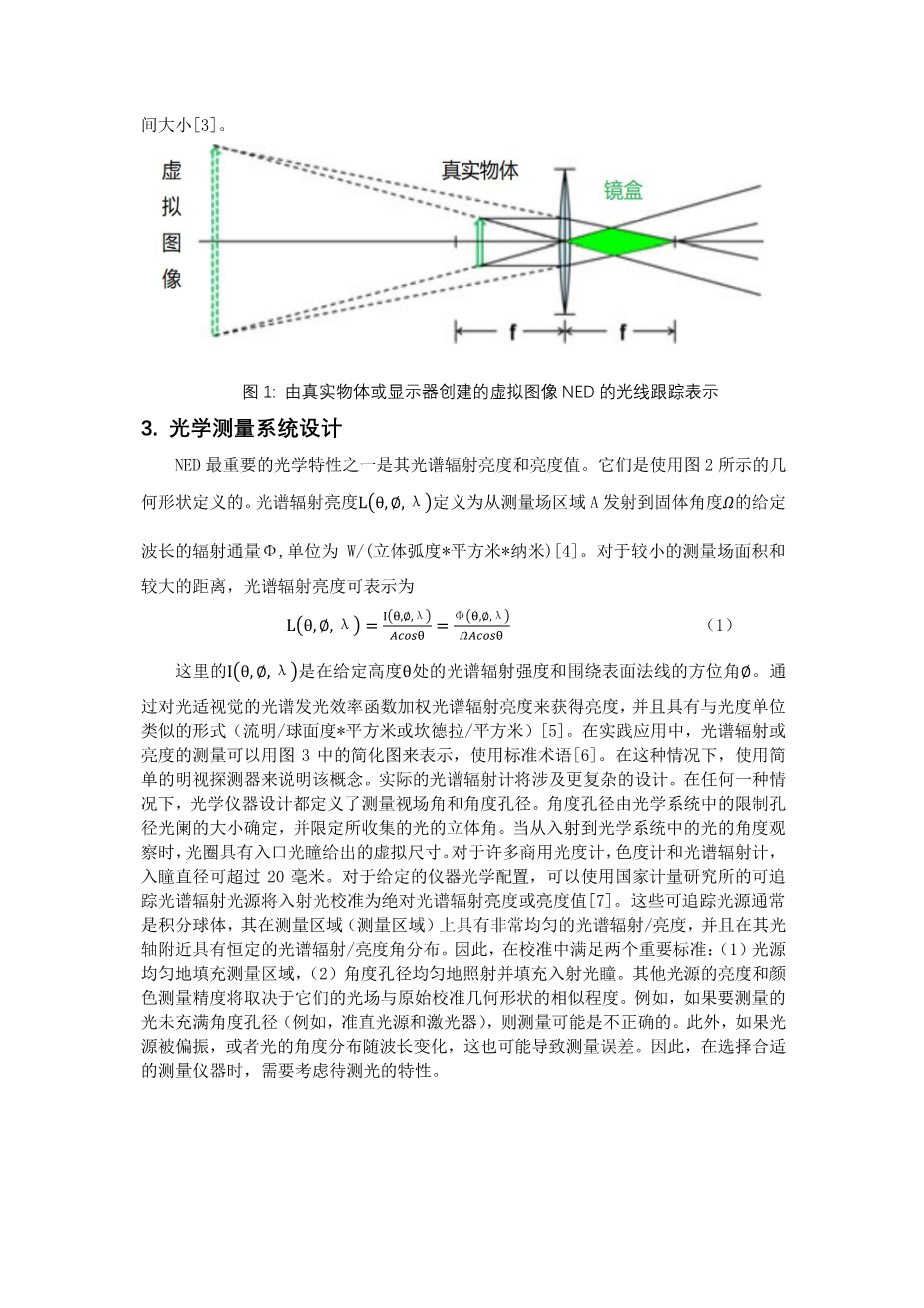附录B 外文原文
Absolute radiometric and photometric measurements of near-eye displays
John Penczek (SID Member) Paul A. Boynton (SID Member)
Frederick M. Meyer (SID Member) Eric L. Heft
Richard L. Austin (SID Member) Thomas A. Lianza (SID Member)
Lukas V. Leibfried Luca W. Gacy
The arrival of near-eye displays has challenged the traditional methods that have been used to measure the optical properties of displays. Near-eye displays typically create virtual images and are designed for the relatively small entrance pupil of the human eye. These two attributes result in optical measurement requirements that are substantially different from traditional flat panel displays. This paper discusses the optical system requirements needed to make absolute radiometric and photometric measurements of near-eye displays. These guidelines are contrasted with the performance of current optical measurement instruments. An initial study was conducted using traditional and modified instruments and exhibited a significant variance in the results with different near-eye display designs. The study demonstrated that some traditional optical instruments can yield erroneous results when used to measure near-eye displays. Generic optical system design concepts were used to interpret the experimental results and helped to identify how current commercial designs could be modified to properly measure near-eye displays.
Keywords:augmented reality, virtual reality, near-eye displays, display metrology, photometry, entrance pupil.
1 Introduction
There has been significant effort in developing devices for augmented reality (AR) and virtual reality (VR) applications. These devices hold great potential for revolutionizing the human-computer interface and enhancing productivity. However, relatively little research has been performed in understanding the optical requirements necessary to measure the absolute radiometric and photometric properties of AR/VR devices. This article strives to define some of these requirements and raise the awareness of instrument manufacturers and users of the unique measurement challenges posed by AR/VR devices.
2 First-order near-eye display optical design
Conventional optical measurement instruments are generally designed to measure the light produced from real images. A real image can be observed by placing a piece of paper or bare sensor at the focal plane of a projected image, like a projection screen. But a display that creates a virtual image requires an imaging system (like the human eye) to reconstruct a real image of the object.
Many AR/VR devices are designed to be compact, so they can be worn on the head (like eye glasses). In this case,the eye pupil is often about 25 mm away from the mechanical envelope of the output optical element. Because the human eye cannot comfortably focus at this distance,the near-eye display (NED) configuration is used, which typically uses a virtual image optical design. A simple example of a virtual image design is shown in Fig. 1. In contrast to the situation where a real object creates a real inverted image at the opposite side of the positive lens, a virtual image is created on the same side as the real object when the object is moved inside the focal length (f) of a positive lens[1]. When the virtual image is a large distance away from the lens (a typical NED configuration), then points of light on the object will create nearly parallel rays to the right of the lens. A second lens, like that in the human eye, would then focus those rays on a focal plane(or retina). For non-pupil forming designs, light from the geometric boundaries of the virtual image would define a volume behind the lens called the eye box (Fig. 1)[2]. If an eye with pupil diameter smaller than the eye box is placed within the eye box, it would be able to view the entire virtual image. Recent work demonstrated that an optical instrument with a small entrance pupil can be used to scan across the eye box and determine its spatial size[3].
FIGURE 1 — Ray trace representation of a virtual image NED created by a real object or display.
3 Optical measurement system design
One of the most important optical characteristics of the NED is its spectral radiance and luminance values. They are defined using the geometry illustrated in Fig. 2. The spectral radiance L(θ,ϕ,λ) is defined as the radiant flux Φ at a given wavelength emitted from measurement field area A into a solid angle Ω and has units of W/(steradian*m 2 *nm). 4 For the case of small measurement field areas and large distances, the spectral radiance can be expressed as
(1)
where I(θ,ϕ,λ) is the spectral radiant intensity at a given elevation θ and azimuth ϕ angle about the surface normal.The luminance is obtained by weighting the spectral radiance by the spectral luminous efficiency function for photopic vision and has a similar form with photometric units (lumen/sr*m 2 or candela/m 2 )[5]. In practice, the measurement of spectral radiance or luminance can be represented by the simplified diagram in Fig. 3, using standard terminology[6]. In this case, a simple photopic detector is used to illustrate the concept. An actual spectroradiometer would involve a more complex design. In either case, the optical instrument design defines the measurement field angle and angular aperture. The angular aperture is determined by the size of th
剩余内容已隐藏,支付完成后下载完整资料


英语译文共 11 页,剩余内容已隐藏,支付完成后下载完整资料
资料编号:[435852],资料为PDF文档或Word文档,PDF文档可免费转换为Word
以上是毕业论文外文翻译,课题毕业论文、任务书、文献综述、开题报告、程序设计、图纸设计等资料可联系客服协助查找。


